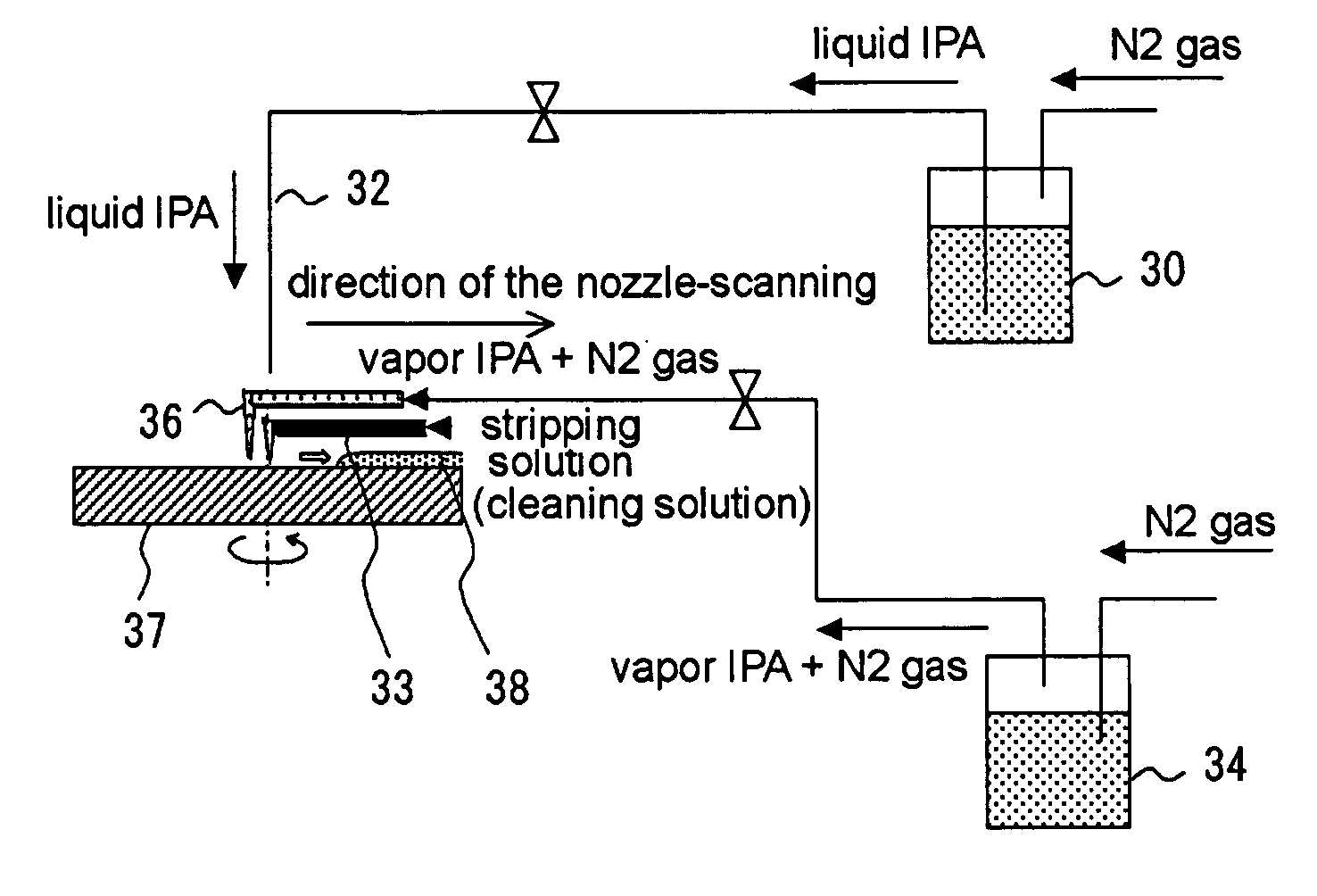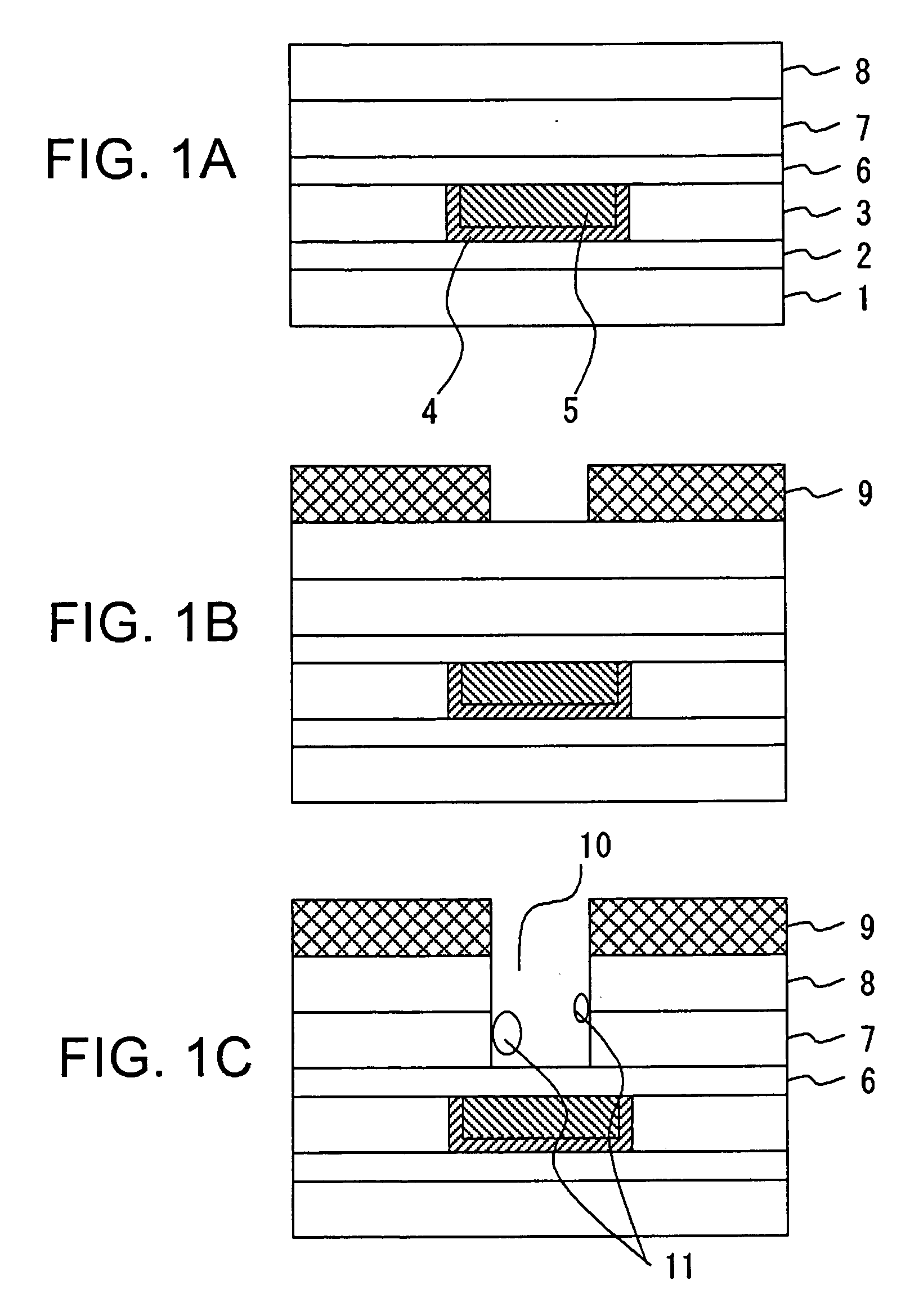Method of manufacturing semiconductor device and apparatus for cleaning substrate
a technology for semiconductor devices and substrates, applied in the direction of cleaning using tools, cleaning using liquids, chemistry apparatus and processes, etc., can solve the problems of increasing production costs and environmental load, reducing production yield, and reducing substrate throughpu
- Summary
- Abstract
- Description
- Claims
- Application Information
AI Technical Summary
Benefits of technology
Problems solved by technology
Method used
Image
Examples
second embodiment
2. SECOND EMBODIMENT
[0086] The embodiment illustrates the case where a transistor is formed in a device formation region of a substrate and the substrate is rinsed using the method according to the invention after formation of a gate of the transistor. A process according to the present embodiment will be described with reference to FIGS. 7A-D and 8A-D.
[0087] First, as shown in FIG. 7A, a silicon substrate 50 is thermally oxidized to form a silicon oxide film 52 on the silicon substrate 50 and a high dielectric constant (high-k) insulating film 54 is deposited thereon by CVD or sputtering, and further, a polysilicon layer 56 is deposited thereon by CVD.
[0088] Subsequently, a resist film is coated on the polysilicon layer 56 and patterned by a lithography technique using ArF excimer laser to form a resist layer 58, as shown in FIG. 7B. Thereafter, as shown in FIGS. 7C and 7D, the polysilicon layer 56 and high-k insulating film 54 are selectively dry-etched in this order using the res...
third embodiment
3. THIRD EMBODIMENT
[0095] The embodiment illustrates the case where a transistor is formed in an I / O region of a substrate and the substrate is rinsed using the method according to the invention after formation of a gate of the transistor. A process according to the embodiment will be described with reference to FIGS. 9A, 9B and 10A-C.
[0096] First, as shown in FIG. 9A, a silicon substrate 50 is thermally oxidized to form a silicon oxide film 52 on the silicon substrate 50 and a high-k insulating film 54 is deposited thereon by CVD or sputtering, and further, a polysilicon layer 56 is deposited thereon by CVD.
[0097] Subsequently, a resist film is coated on the polysilicon layer 56 and patterned by a lithography technique using an I-beam (365 nm) to form a resist layer 65, as shown in FIG. 9B. Thereafter, the polysilicon layer 56, high-k insulating film 54 and the silicon oxide film 52 are selectively dry-etched using the resist layer 65 as a mask to form a gate electrode (FIG. 10A).
[...
example
[0101] In the example, a lower interconnect line made of copper and an upper interconnect line made of copper were connected through a via plug by a single damascene process to form a two level interconnect structure were and then the yield of chips each containing the two level interconnect structure is evaluated. In forming the interconnect structure, wafers to be evaluated were rinsed in various manners after formation of through-holes and removal of resist, and then, the wafers were evaluated in terms of how the rinse affect the yield of chips each containing the interconnect structure.
[0102] Samples for evaluation were manufactured in the following manner. A lower interconnect line and a via plug were formed in the manner similar to that described in the First Embodiment. First, a copper interconnect was formed on a silicon wafer. Then, a silicon nitride film having a thickness of 90 nm, a low-k film having a thickness of 450 nm and a silicon oxide film having a thickness of 45...
PUM
| Property | Measurement | Unit |
|---|---|---|
| speed | aaaaa | aaaaa |
| thickness | aaaaa | aaaaa |
| thickness | aaaaa | aaaaa |
Abstract
Description
Claims
Application Information
 Login to View More
Login to View More - R&D
- Intellectual Property
- Life Sciences
- Materials
- Tech Scout
- Unparalleled Data Quality
- Higher Quality Content
- 60% Fewer Hallucinations
Browse by: Latest US Patents, China's latest patents, Technical Efficacy Thesaurus, Application Domain, Technology Topic, Popular Technical Reports.
© 2025 PatSnap. All rights reserved.Legal|Privacy policy|Modern Slavery Act Transparency Statement|Sitemap|About US| Contact US: help@patsnap.com



